
Diamond properties and virtues
Contents:
Diamonds come from an Indian kingdom called Mutfili. After the rainy season, water from the mountains carries them into deep valleys. These damp and warm places are teeming with venomous snakes and their terrible presence guards this fabulous treasure. Men full of lust throw pieces of meat on the ground, diamonds stick to them, and white eagles rush to these baits. Large birds of prey are caught and killed, meat and diamonds are extracted from their claws or from their stomachs.
Marco Polo describes this curious scene in his travel stories. This is just an old legend that existed long before him, but it testifies to the ancestral exploitation of alluvial deposits in Golconda, the ancient kingdom of mysterious India...
Mineralogical characteristics of diamond
Diamond is the same native element as gold or silver. Only one element is involved in its formation: carbon. It belongs to the category of native non-metals with graphite (also composed of carbon but with a different structure) and sulfur.
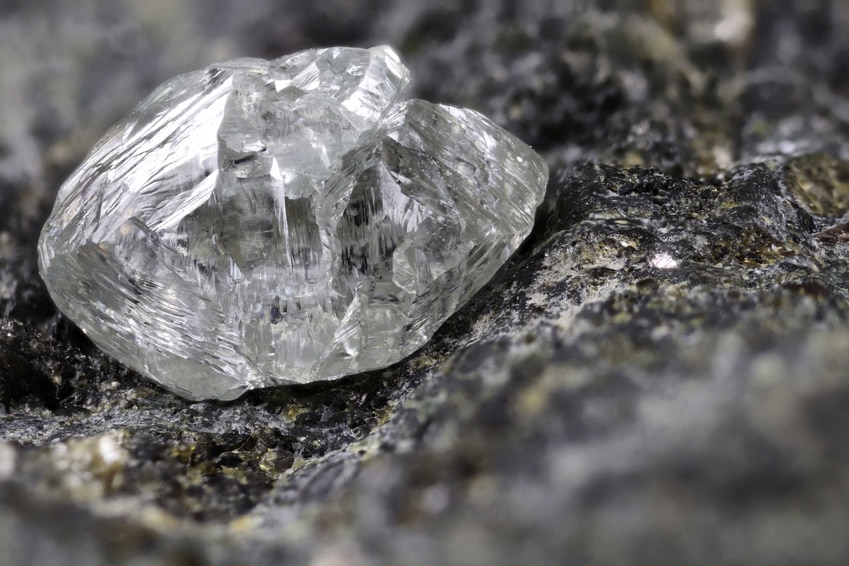
Found in rocks and alluvial sands. The sources of its rocks are lamproites and especially kimberlites. This rare volcanic rock, also called "blue earth", formed at the end of the Cretaceous. It owes its name to the city of Kimberley in South Africa. Very rich in mica and chromium, may also contain garnets and serpentines.
Diamonds are formed in the upper mantle of the earth at a very great depth, at least 150 km. They stay there for millions of years. before being ejected from the chimneys, called chimneys or diatremes, of formidable kimberlite volcanoes. The last dazzling eruptions of this type date back 60 million years.
The diamonds contained in alluvium are transported by water, without changing due to their hardness, over considerable distances. They can be found in estuaries and on the seabed.
The slow and steady growth of carbon atoms favors well-formed crystals, most often octahedral. (the central atom plus 6 other points form 8 faces). Sometimes we find figures with 8 or 12 points. There are also irregular shapes called granuloforms, exceptional large crystals weighing more than 300 carats are almost always of this type. Most diamonds do not exceed 10 carats.
Diamond hardness and brittleness
Diamond is the hardest mineral present on earth. The German mineralogist Frederick Moos took it as a basis when creating his mineral hardness scale in 1812. So he puts it in 10th place out of 10. A diamond scratches glass and quartz, but only another diamond can scratch it.
Diamond is hard but inherently brittle. Its cleavage, i.e., the arrangement of the layers of its molecules, is natural. This promotes clean tearing at certain angles. The tailor, more precisely, the billhook, observes and uses this phenomenon. Sometimes the volcanic eruption that produced the diamond causes a very smooth separation and thus creates a natural split.
diamond cut
Naturally cut diamonds are said to have "naive points"., we call " simple-minded » Rough diamonds with a polished look.
The diamond is usually covered with a grayish rind, often referred to as gravy » (gravel in Portuguese). After this dirt is removed, size reveals all the clarity and brilliance of the stone. It is a subtle art and a work of patience. The cutter often has to choose between a simple cut, which retains the weight of the rough diamond, or a very complex cut, which can remove two-thirds of the original stone.
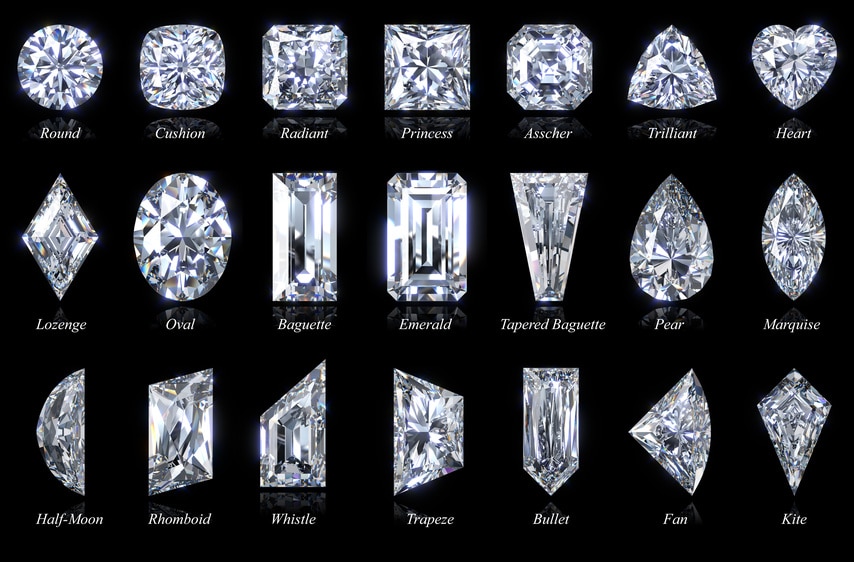
There are a large number of dimensional forms, named and systematized. The most popular cut currently is the Brilliant Round. where light plays wonderfully in 57 facets of a diamond. This is the one at the very top left in the photo above (“year" in English).
diamond colors
Colored diamonds are commonly referred to as "fancy" diamonds. In the past, the color was often considered a defect, the diamond had to be white or very light blue. They were then accepted on the condition that they were "perfect and resolute". They should not affect the brilliance, brilliance and water (clarity) of the diamond. Under these conditions, the cost of a natural colored diamond may exceed the cost of a "white" diamond.
A color that is already bright in its rough state is more likely to impart a beautiful sparkle to a colored diamond. Orange and purple diamonds are the rarest, other colors: blue, yellow, black, pink, red and green are also in demand, and there are very famous specimens. Minerologist René Just Gahuy (1743-1822) called colored diamonds "coloured". mineral kingdom orchids ". These flowers were much rarer then than they are today!
All diamonds affected by small red dots, graphite inclusions or other defects, called "gendarmes", are rejected from jewelry. Unflattering color diamonds (yellowish, brownish), often opaque, are also screened out. These stones, called natural diamonds, are used in industries such as cutting glass.
Color change is possible by irradiation or heat treatment. This is a scam that is difficult to detect and is common.
Major modern diamond mining sites
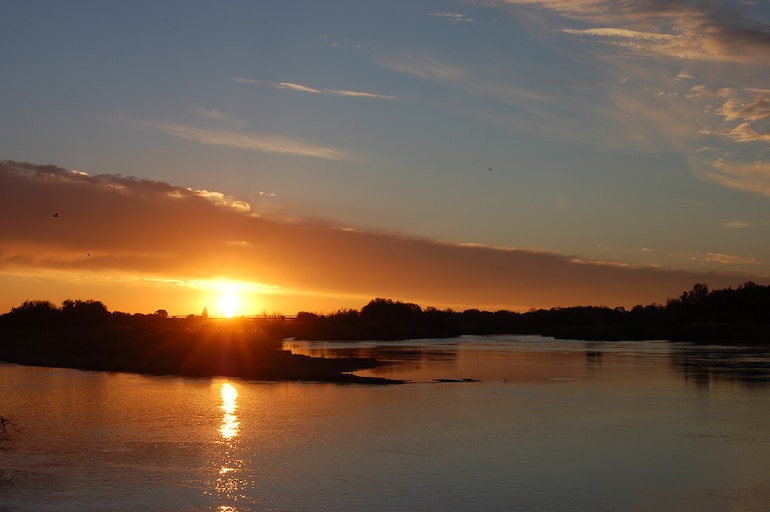
65% of world production is in African countries:
- Afrique du Sud :
In 1867, on the banks of the Orange River, diamonds were discovered in an altered kimberlite called "yellow earth". Then deeper and deeper mines were intensively exploited. Today, the deposits are practically exhausted.
- Angola, Good quality.
- Botswana, a very good quality.
- Ivory Coast, artisanal mining.
- Ghana, placer deposits.
- Guinea, beautiful crystals are often white or white-yellow.
- Lesotho, alluvial deposits, handicraft production.
- Liberia, mostly industrial quality diamonds.
- Namibia, alluvial gravel from the Orange River, very good quality.
- Central African Republic, placer deposits.
- Democratic Republic of the Congo, good quality, often yellow.
- Sierra Leone, beautiful crystals of a good size.
- Tanzania, small crystals, sometimes colored and industrial crystals.
There are other places of extraction:
- Australia, Argyle Mines: giant open pit, pink diamonds.
- Brazil, placer deposits. In particular, in the mining centers of Diamantino in Malto Grosso (often colored diamonds) and Diamantina in Minas Gerais (small crystals, but very good quality).
- Canada, extension.
- China, very good quality, but still handicraft production
- Russia, beautiful diamonds, cold makes production difficult.
- Venezuela, small crystals, gems and industrial quality.
La Finland is the only producing country in the European Union (small quantities).
Etymology of the word "diamond".
Because of its extreme hardness, it is called Adamas meaning in Greek: indomitable, invincible. Oriental people call it almas. The magnet is also labeled Adamas by some ancient authors, hence some confusion. The term "adamantine" means in French the brilliance of a diamond, or something comparable to it.
We do not know why the rhombus lost the prefix a, which in Greek and Latin is the gatekeeper. Removing it, we get the opposite value of the original, namely: tameable. It must be adamant, or a diamond, or maybe a diamond.
In the Middle Ages, the diamond was written in different ways: diamond, on the fly, diamond, diamanz, diamond. Until the XNUMXth century, diamonds often lost the final "t" in the plural: diamonds. In ancient books, a diamond is sometimes called he did which means "without nightmares" due to its merits in lithotherapy.
Diamond Through History
Its real operation begins in India (as well as Borneo) around 800 BC. and continued there until the 20th century. At that time, there were 15 mines in the kingdom of Golconda and XNUMX in the kingdom of Visapur. Diamonds from Brazil, the wealth of Portugal, have replaced them since 1720. and will become more and more abundant until it threatens market prices. Then in 1867 diamonds came from South Africa. In 1888, the British businessman Cecil Rhodes founded the De Beers company here, in fact, a monopolist in the commercial exploitation of diamonds.
Diamond in antiquity
In his » Treaty of the Twelve Gems “, Bishop Saint Epiphanes of Salamis, born in Palestine in the XNUMXth century AD, describes the breastplate of the high priest Aaron, quoted in the book of Exodus of the Old Testament: during the three great feasts of the year, Aaron enters the sanctuary with a diamond on his chest”, Its color resembles the color of air ". The stone changes color according to predictions.
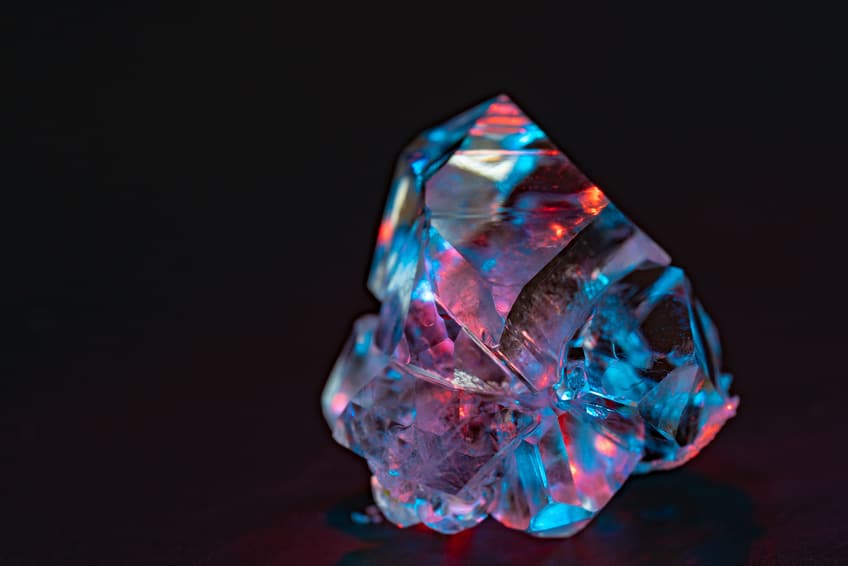
The British Museum in London has a bronze Greek statuette, dated to 480 BC, of a woman richly dressed and elaborately styled with braids and curls. The pupils of his eyes are rough diamonds.
« Adamas is known only to a very small number of kings. Pliny the Elder wrote in the XNUMXst century AD. It lists six types of diamonds, including one no larger than a cucumber seed. According to him, the most beautiful diamond is Indian, all the rest are mined in gold mines. These gold mines may refer to Ethiopia. Then it is, of course, only a stopover. Antique diamonds come from India via the Red Sea.
Pliny insists on the resistance of diamond to fire and iron. Having lost all measure, he proposes to hit them with hammers on the anvil to check their authenticity, and soak them in warm goat blood to soften!
Due to its rarity, as well as its hardness, the diamond is not a fashionable piece of jewelry. Its special qualities are used in cutting and engraving more docile stones. Encased in iron, diamonds become ideal tools. The Greek, Roman and Etruscan civilizations use this technique, but the Egyptians do not know it.
Diamond in the Middle Ages
The size is even less developed, and the beauty of the stone remains cumulative. Rubies and emeralds are more attractive than diamonds, and a simple cabochon cut is enough for these colored stones. However, Charlemagne closes his imperial uniform with a clasp made from a rough diamond. Later, the texts mention several royal persons who own diamonds: Saint-Louis, Charles V, favorite of Charles VII, Agnès Sorel.
Pliny's recipe for softening it is always recommended and even improved:
A goat, preferably white, must first be fed with parsley or ivy. He will also drink good wine. Then something goes wrong with the poor beast: he is killed, his blood and flesh are heated, and a diamond is poured into this mixture. The softening effect is temporary, the hardness of the stone is restored after a while.
There are other less bloody means: a diamond thrown into red-hot and molten lead disintegrates. It can also be dipped in a mixture of olive oil and soap and comes out softer and smoother than glass.
Traditional virtues of a diamond
Herbalism and lithotherapy occupied an important place in the Middle Ages. The knowledge of the Greeks and Romans is preserved by adding an extra dose of magic. Bishop Marbaud in the XNUMXth century and later Jean de Mandeville tell us about the many benefits that a diamond brings:
It gives victory and makes the wearer very strong against enemies, especially when worn on the left side (sinistrium). It fully protects the limbs and bones of the body. It also protects against madness, strife, ghosts, poisons and poisons, bad dreams and dream turmoil. Breaks enchantments and spells. He heals the mad and those created by the devil. He even scares away demons who turn into men to sleep with women. In a word, "he decorates everything."
The offered diamond has more strengths and merits than the purchased diamond. Those with four sides are rarer, therefore more expensive, but they have no more strength than others. As a result, The dignity of a diamond is not in its shape or size, but in its very essence, in its secret nature. This teaching comes from the great sages of the country Imde (India)" where the waters converge and turn into crystal .
Diamond in the Renaissance
The belief that diamond resists iron and fire is tenacious. So, during the Battle of Moras in 1474, the Swiss cut with axes the diamonds found in the tent of Charles the Bold to make sure they were real.
At the same time, a jeweler from Liège, Louis de Berken or Van Berkem would accidentally find a way to make them more shiny by rubbing them together. The size technique would then progress thanks to him. This story does not seem plausible because we do not find traces of this character.
The evolution, however, dates back to this period and probably comes from the north, where the gem trade flourishes. We learn to delicately carve a few regular edges : in a shield, in a chamfer, in a point and even in a rose (with edges, but with a flat bottom, which has always been appreciated today).
Diamond is more common in princely inventories. Agnes of Savoy's book dated 1493 mentions: cloverleaf ring with large emerald, diamond plate and ruby cabochon .
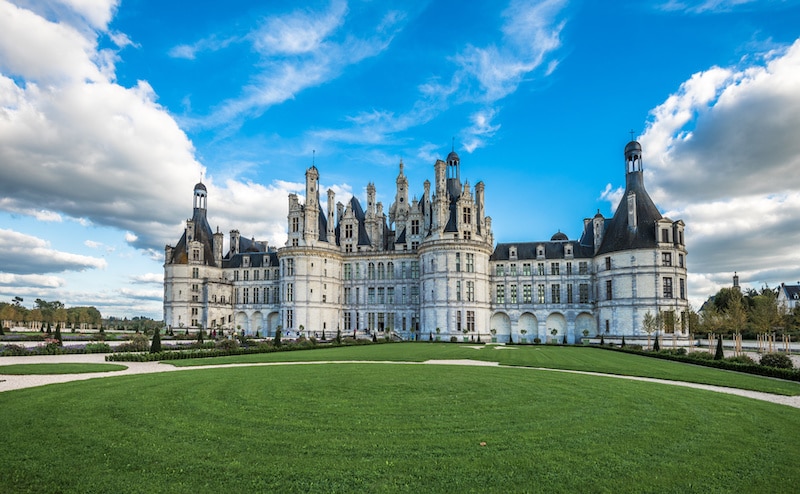
The famous anecdote, according to which François I would like to use the diamond of his ring to write a few words on the window of the Château de Chambord, is reported by the writer and chronicler Brantome. He claims that the old guard of the castle led him to the famous window, saying to him: " Here, read this, if you haven't seen the King's handwriting, my lord, here it is... »
Brantome then contemplates the clear inscription engraved in large letters:
“Often a woman changes, clumsy, who counts on it. »
The king, despite his cheerful disposition, must have been in a gloomy mood that day!
Diamond in the 17th century
Jean-Baptiste Tavernier, born in 1605, is the son of a Protestant geographer from Antwerp. This one, persecuted in his own country, settles in Paris during the period of tolerance. Fascinated by his father's travel stories and mysterious maps from childhood, he became an adventurer and dealer in precious materials with a penchant for diamonds. He is perhaps the first to say: "Diamond is the most precious of all stones."
In the service of the Duke of Orleans, he traveled to India six times:
Fear of danger never forced me to retreat, even the terrible picture that these mines presented could not frighten me. So I went to the four mines and one of the two rivers from which the diamond is mined, and found neither these difficulties nor this barbarity described by some ignoramuses.
J. B. Tavernier writes his memoirs and thus makes a great contribution to the knowledge of the East and diamonds. He describes a landscape full of rocks and thickets, with sandy soil, reminiscent of the forest of Fontainebleau. He also reports amazing scenes:
- The workers, completely naked to avoid theft, steal some stones by swallowing them.
- Another "poor fellow" sticks a 2-carat diamond in the corner of his eye.
- Children aged 10 to 15 years, experienced and cunning, organize for their own benefit intermediary trade between manufacturers and foreign customers.
- The Orientals value their diamonds by placing an oil lamp with a strong wick in a square hole in the wall, they return at night and inspect their stones by this light.
The end of the life of this tireless traveler was interrupted by the repeal of the Edict of Nantes, he left France in 1684 to die in Moscow a few years later.
Diamond in the 18th century
Combustibility of diamond
Isaac Newton, a lonely and suspicious man, had only the company of a small dog named Diamond. Did he give him the idea to become interested in this mineral? Perhaps because he mentions it in his treatise on optics, published in 1704: diamond would be a possible fuel. Others thought about it long before him, such as Boes de Booth, author of " History of gems in 1609. The Irish chemist Robert Boyle conducted an experiment in 1673: the diamond disappeared under the influence of the intense heat of the furnace.
The same attempts are repeated everywhere, in front of dumbfounded spectators.. A large number of diamonds pass through the furnace; the exorbitant cost of these experiments does not discourage the wealthy patrons who fund them. François de Habsburg, husband of Empress Marie-Therese, subsidizes trials for the combined burning of diamonds and rubies. Only rubies saved!
In 1772, Lavoisier stated that the diamond was an analogy to coal, but " it would be unwise to go too far in this analogy. .
The English chemist Smithson Tennant demonstrated in 1797 that diamond consumes oxygen due to its high carbon content. When diamond burns with atmospheric oxygen, it turns into carbon dioxide, since only carbon is included in its composition.
Will a delightful diamond be a luxurious charcoal? Not really, because it comes from the great bowels of the earth and we can say like the Enlightenment mineralogist Jean-Étienne Guettard: “ nature has not created anything so perfect that it can be compared .
famous diamonds
There are a lot of famous diamonds, often they are named after their owner: the diamond of the Emperor of Russia, the size of a pigeon's egg, the diamond of the Grand Duke of Tuscany, slightly lemon-colored, and the diamond of the Great Mogul, never found, weighing 280 carats, but with a small defect. Sometimes they are identified by color and place of origin: Dresden green, of medium brilliance, but of a beautiful deep color; The red color of Russia was bought by Tsar Paul I.
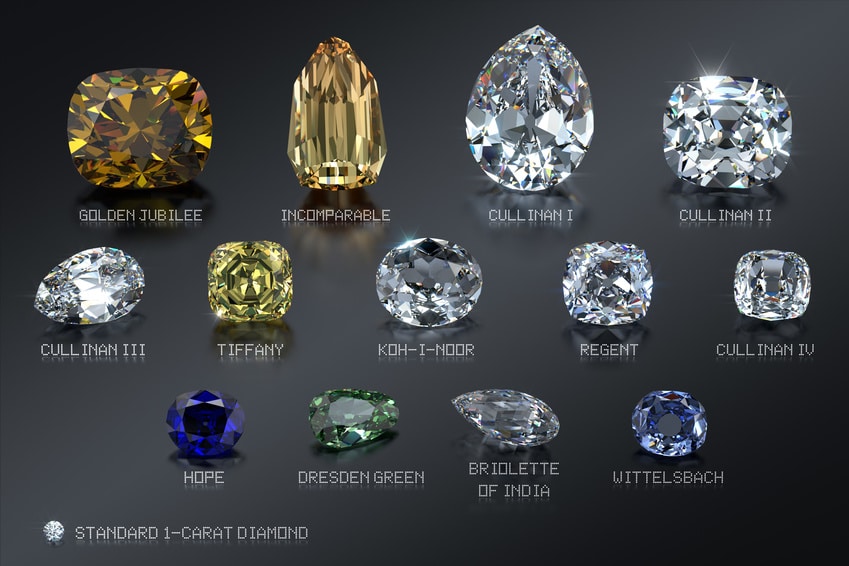
One of the most famous is Koh-I-Noor. Its name means "mountain of light". This 105-carat white with gray highlights is likely from the Parteal mines in India. Its origin is considered divine as its discovery dates back to the legendary times of Krishna. Declared an English possession by right of conquest during the reign of Queen Victoria, it can be seen wearing the British Crown Jewels in the Tower of London.
To quote three historical French celebrities:
Sancy
Sancy or Grand Sancy (Bo or Petit Sancy is another gem). This 55,23 carat white diamond has exceptional water. He comes from the East Indies.

Charles the Bold was the first known owner before it was acquired by the King of Portugal. Nicholas Harlay de Sancy, Henry IV's finance manager, bought it in 1570. It was sold to Jacques I of England in 1604 and then returned to France, bought by Cardinal Mazarin, who bequeathed it to Louis XIV. It is placed on the crowns of Louis XV and Louis XVI. Lost during the revolution, found two years later, sold several times before being owned by the Astor family. The Louvre bought it in 1976.
France blue
France blue, originally weighing 112 carats, dark blue, comes from the vicinity of Golconda, India.
Jean-Baptiste Tavernier sold it to Louis XV in 1668. This famous diamond has survived a thousand adventures: theft, loss, many royal and wealthy owners. It is also cut off several times.
London banker Henry Hope bought it in 1824 and gave it his name, thus gaining a second fame and a second life. It now weighs "only" 45,52 carats. Hope is now visible at the Smithsonian Institution in Washington.
Le Regent
Le Regent, 426 carats rough, over 140 carats cut, white, from the Partil mines, India.
Its purity and size are extraordinary, and it often considered the most beautiful diamond in the world. Its brilliant cut is made in England and will last two years.
Regent Philippe d'Orléans bought it in 1717 for two million pounds, and in two years its value tripled. First it was worn by Louis XV, and then by all French sovereigns up to the Empress Eugenie (it was stolen and disappeared for a year during the revolution). Now the Regent shines in the Louvre.
Diamond jewelry can also be famous for its beauty, but even more so for its history. The loudest, of course, is "The Case of the Queen's Necklace".
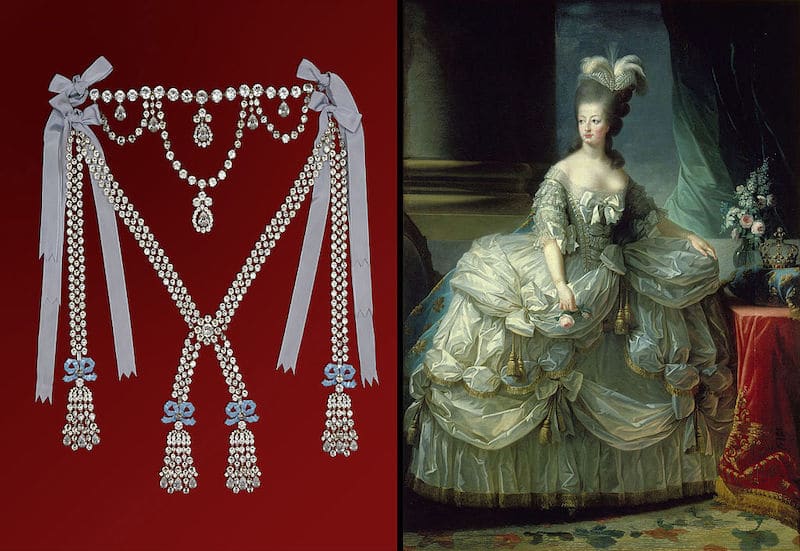
In 1782, Marie Antoinette wisely resisted the temptation, she refused this necklace, consisting of 650 diamonds (2800 carats), a madness offered at an exorbitant price! In a few years, a gigantic scam will finally compromise her. The Queen has been the victim of some sort of identity theft.. Guilty and accomplices are punished differently. Marie Antoinette is innocent, but the scandal irreversibly fuels the hatred of the people. What you can see at the Smithsonian in Washington is not the Queen's necklace, but diamond earrings that should have been hers.
heavenly diamonds
Precious meteorite
In May 1864, a meteorite, probably a fragment of a comet, fell in a field in the small village of Orgay in Tarn-et-Garonne. Black, smoky and glassy, it weighs 14 kg. This very rare chondrite contains nanodiamonds. Samples are still being studied around the world. In France, the works are exhibited in the natural history museums of Paris and Montauban.
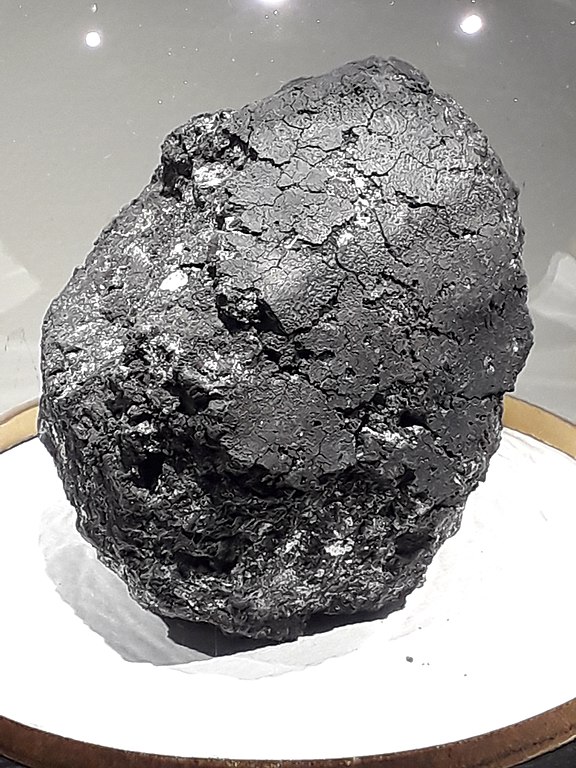
diamond planet
This rocky planet has a more strict name: 55 Cancri-e. Astronomers discovered it in 2011 and found it to be composed mostly of diamonds.
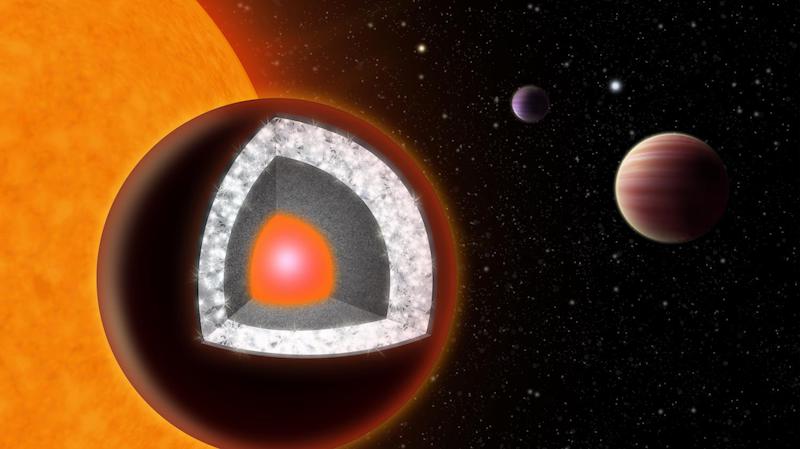
Twice the size of the Earth and nine times the mass, it does not belong to the solar system. It is located in the constellation Cancer, 40 light years away (1 light year = 9461 billion km).
We already imagine the magical planet explored by Tintin, his brave Snowball, frolicking among the dazzling stalagmites of giant diamonds. Research is ongoing, but the reality is probably not so beautiful!
Properties and advantages of diamond in lithotherapy
In the Middle Ages, the diamond is an emblem of constancy, a stone of reconciliation, fidelity and conjugal love. Even today, after 60 years of marriage, we celebrate the anniversary of the diamond wedding.
Diamond is an excellent ally of lithotherapy, because in addition to its own qualities, it enhances the virtues of other stones. This reinforcing role conveyed by its extreme power must be used with discernment because it will also tend to amplify negative influences.
White diamond (transparent) symbolizes purity, innocence. Its cleansing action protects against electromagnetic waves.
Diamond Benefits Against Physical Ailments
- Balances metabolism.
- Removes allergies.
- Soothes poisonous bites, stings.
- Helps cure eye diseases.
- Stimulates blood circulation.
- Promotes good sleep, drives away nightmares.
The benefits of diamond for the psyche and relationships
- Promotes a harmonious life.
- Give courage and strength.
- Relieves emotional pain.
- Relieves stress and gives a feeling of well-being.
- Bring hope.
- Attracts abundance.
- Clarifies thoughts.
- Increases creativity.
- Encourages learning, learning.
A diamond brings deep peace to the soul, so it is primarily associated with 7th chakra (sahasrara), the crown chakra associated with spiritual consciousness.
Diamond cleaning and recharge
For cleaning, salted, distilled or demineralized water is perfect for him.
Diamond has such a source of energy that it does not require any special recharging.
One final clarification: the "Herkimer diamond" often referred to in lithotherapy is not a diamond. This is a very transparent quartz from the Herkimer mine in the USA.
Have you been lucky enough to become the owner of a diamond? Did you manage to note for yourself the merits of the sublime mineral? Feel free to share your experience in the comments section below!
Leave a Reply